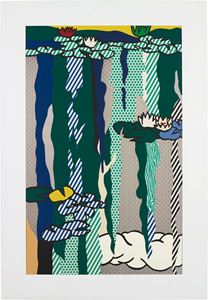About
Roy Fox Lichtenstein was born on October 27, 1923, in New York City, the son of Milton Lichtenstein, a successful real estate developer, and Beatrice Werner Lichtenstein. As a boy growing up on Manhattan's Upper West Side, Lichtenstein had a passion for both science and comic books. In his teens, he became interested in art. He took watercolor classes at Parsons School of Design in 1937, and he took classes at the Art Students League in 1940, studying with American realist painter Reginald Marsh.
Lichtenstein began experimenting with different subjects and methods in the early 1960s, while he was teaching at Rutgers University. His newer work was both a commentary on American popular culture and a reaction to the recent success of Abstract Expressionist painting by artists like Jackson Pollock and Willem de Kooning. Instead of painting abstract, often subject-less canvases as Pollock and others had done, Lichtenstein took his imagery directly from comic books and advertising. Rather than emphasize his painting process and his own inner, emotional life in his art, he mimicked his borrowed sources right down to an impersonal-looking stencil process that imitated the mechanical printing used for commercial art.
Lichtenstein became known for his deadpan humor and his slyly subversive way of building a signature body of work from mass-reproduced images. By the mid-1960s, he was nationally known and recognized as a leader in the Pop Art movement that also included Andy Warhol, James Rosenquist and Claes Oldenburg. His art became increasingly popular with both collectors and influential art dealers like Leo Castelli, who showed Lichtenstein's work at his gallery for 30 years. Like much Pop Art, it provoked debate over ideas of originality, consumerism and the fine line between fine art and entertainment.
By the late 1960s, Lichtenstein had stopped using comic book sources. In the 1970s his focus turned to creating paintings that referred to the art of early 20th century masters like Picasso, Henri Matisse, Fernand Léger and Salvador Dalí. In the 1980s and '90s, he also painted representations of modern house interiors, brushstrokes and mirror reflections, all in his trademark, cartoon-like style. He also began working in sculpture.
Lichtenstein was committed to his art until the end of his life, often spending at least 10 hours a day in his studio. His work was acquired by major museum collections around the world, and he received numerous honorary degrees and awards, including the National Medal of Arts in 1995.
Lichtenstein began experimenting with different subjects and methods in the early 1960s, while he was teaching at Rutgers University. His newer work was both a commentary on American popular culture and a reaction to the recent success of Abstract Expressionist painting by artists like Jackson Pollock and Willem de Kooning. Instead of painting abstract, often subject-less canvases as Pollock and others had done, Lichtenstein took his imagery directly from comic books and advertising. Rather than emphasize his painting process and his own inner, emotional life in his art, he mimicked his borrowed sources right down to an impersonal-looking stencil process that imitated the mechanical printing used for commercial art.
Lichtenstein became known for his deadpan humor and his slyly subversive way of building a signature body of work from mass-reproduced images. By the mid-1960s, he was nationally known and recognized as a leader in the Pop Art movement that also included Andy Warhol, James Rosenquist and Claes Oldenburg. His art became increasingly popular with both collectors and influential art dealers like Leo Castelli, who showed Lichtenstein's work at his gallery for 30 years. Like much Pop Art, it provoked debate over ideas of originality, consumerism and the fine line between fine art and entertainment.
By the late 1960s, Lichtenstein had stopped using comic book sources. In the 1970s his focus turned to creating paintings that referred to the art of early 20th century masters like Picasso, Henri Matisse, Fernand Léger and Salvador Dalí. In the 1980s and '90s, he also painted representations of modern house interiors, brushstrokes and mirror reflections, all in his trademark, cartoon-like style. He also began working in sculpture.
Lichtenstein was committed to his art until the end of his life, often spending at least 10 hours a day in his studio. His work was acquired by major museum collections around the world, and he received numerous honorary degrees and awards, including the National Medal of Arts in 1995.
Also Exhibited by
Also represented by
Work Selection

Water Lilies with Cloud (C. 263
_RoyLichtenstein_T638920618467314108.jpg?width=220&height=300&format=jpg&qlt=80)
Lichtenstein - The New Fall of America (portfolio)